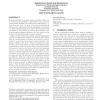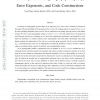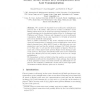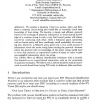15 search results - page 3 / 3 » On Codes, Matroids and Secure Multi-party Computation from L... |
SASN
2006
ACM
13 years 10 months ago
2006
ACM
A great challenge in securing sensor networks is that sensor nodes can be physically compromised. Once a node is compromised, attackers can retrieve secret information (e.g. keys)...
CORR
2007
Springer
13 years 4 months ago
2007
Springer
An analysis of steganographic systems subject to the following perfect undetectability condition is presented in this paper. Following embedding of the message into the covertext,...
EUROCRYPT
2007
Springer
13 years 10 months ago
2007
Springer
We consider the standard secure multi-party multiplication protocol due to M. Rabin. This protocol is based on Shamir’s secret sharing scheme and it can be viewed as a practical ...
MMSEC
2004
ACM
13 years 10 months ago
2004
ACM
In this paper, we introduce a new approach to passive-warden steganography in which the sender embeds the secret message into a certain subset of the cover object without having t...
EUROCRYPT
1995
Springer
13 years 8 months ago
1995
Springer
We coiisider a situation where two parties, Alice and Bob, share a common secret string arid would like to mutually check their knowledge of that string. We describe a simple and e...




